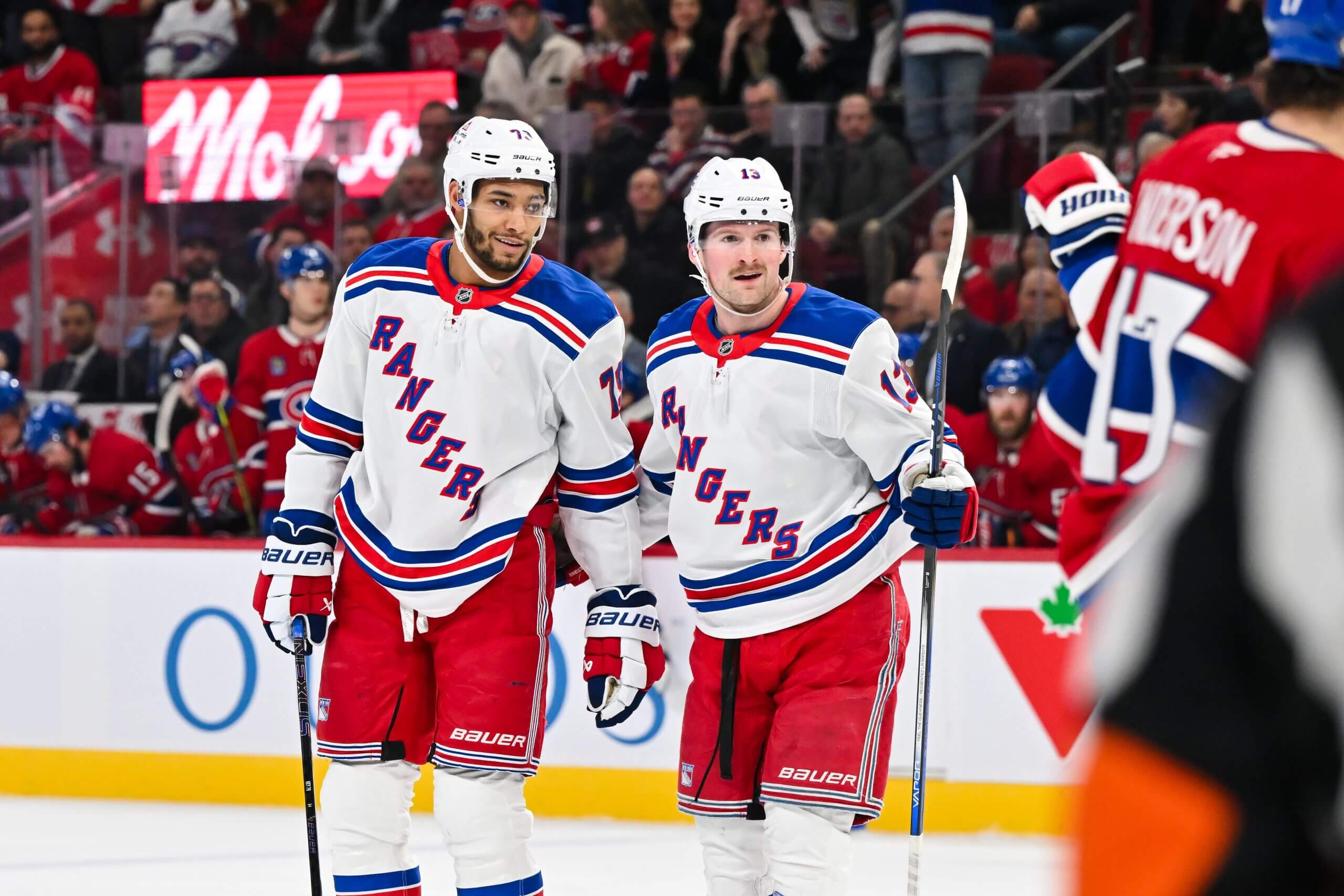
Did you see Ivan Demidov’s debut Monday? The way he made the Bell Centre crowd pop? The skill and skating and ability to rise to a moment?
The Montreal Canadiens rookie created excitement that radiated through television screens. It was palpable.
When’s the last time the New York Rangers had that?
When’s the last time they have had a rookie like Lane Hutson, for that matter? Or a second-year player like the Columbus Blue Jackets’ Adam Fantilli?
Advertisement
New York is an older club. That has benefits when a team is close to summiting the Stanley Cup mountain. When a team is middling, though, it means it is stuck. It makes the future feel bleak.
It leaves general manager Chris Drury and the Rangers with a hard reality to confront. Not only have they been passed by other teams, but they’ve been passed by younger teams better suited for the future.
Just look at the wild-card standings. Montreal has the 21-year-old Hutson, who’s likely to win the Calder Trophy. It has Nick Suzuki and Cole Caufield, both still under 26, and it has 21-year-old Juraj Slafkovsky, who has back-to-back 50-point seasons. None of those players are included in their prospect pool, which, led by Demidov, were No. 3 in The Athletic’s Scott Wheeler’s leaguewide rankings in February.
The Ottawa Senators, who erased a multi-goal third-period deficit to hand the Rangers a devastating loss in March, clinched a playoff berth last week. Captain Brady Tkachuk is only 25 and — before anyone gets ahead of themselves — still has three years left on his deal after this one. Tim Stützle and Jake Sanderson, both picked behind Alexis Lafrenière in the 2020 draft, look like franchise lynchpins.
The Blue Jackets, still alive in the playoff race, have four 20-plus goal scorers under 25 and are No. 6 in Wheeler’s prospect pool rankings. Fantilli could join Zach Werenski as the faces of the franchise.
The Rangers already missed the playoffs this season. The youth on other teams only makes New York’s hole harder to climb out of going forward.
The likes of Montreal, Ottawa and Columbus are on the way up. The Rangers might not be. They have a middle-of-the-pack prospect pool (No. 19, according to Wheeler) and gave up one of their next two first-round picks to acquire J.T. Miller in January.
Lafrenière, the No. 1 pick in 2020, was supposed to be the future face of the team. After an up-and-down first three seasons, he looked like he might finally be morphing into the part in 2023-24, logging 28 goals and 57 points — 51 of which were at even strength. He had eight goals in 16 playoff games, further raising expectations coming into 2024-25. This season, with his 45 points and inconsistent defense, has been a massive step back. The talk of him being a generational talent is long gone.
Advertisement
With 20 goals this year, 23-year-old Will Cuylle looks like he’ll be an impact player for years to come, but more in a complementary role than as a superstar. The same goes for Braden Schneider. They are the type of players good teams need but not ones that define cores.
Gabe Perreault, a 2023 first-round pick, is an exciting prospect, but declaring him a franchise savior is hardly fair to the 19-year-old. Not to mention that New York doesn’t have a sterling record of developing its first-round forwards. Kaapo Kakko (No. 2 pick in 2019), Vitali Kravtsov (No. 9 pick in 2018), Lias Andersson (No. 7 pick in 2017) and Filip Chytil (No. 21 pick in 2017) are no longer with the organization, and Kravtsov and Andersson are no longer playing on this continent. Brennan Othmann, the 15th player selected in 2021, has yet to get consistent NHL playing time, though he’s still only 22.
The Rangers’ pool of young players would all be fine if they had a star-powered core like the Tampa Bay Lightning or Florida Panthers. New York has only pieces. Artemi Panarin is an elite winger, Igor Shesterkin is a franchise goalie, and Adam Fox is a No. 1 defenseman. J.T. Miller could be the No. 1 center on a Stanley Cup team, but he’s not in the realm of Connor McDavid, Nathan MacKinnon, Leon Draisaitl, Sidney Crosby and the league’s other top centermen. Mika Zibanejad and Vincent Trocheck both regressed in 2023-24, and Chris Kreider’s production plummeted.
None of those forwards are young, either. Panarin and Kreider are 33. Miller is 32, and Zibanejad and Trocheck will both turn 32 by the start of next season. The team’s window is designed to be now, because it’s no certainty these players will be close to the same level in a few years.
There are no easy outs for the Rangers. Given recent history and the disappointment of this season, Drury will likely fire Peter Laviolette. A new voice will probably bring a boost to the dressing room, just like Laviolette did initially, and perhaps some of the team’s players will bounce back from disappointing seasons. But they’d probably all need to return to around their career-best levels for New York to truly be a contender.
Advertisement
Drury will continue trying to rework the roster, but the team lacks the salary cap flexibility needed to do much before next season. Drury created some by offloading Jacob Trouba to the Ducks, but he used it to ensure Will Borgen, Urho Vaakanainen and Carson Soucy are under contract for next year. Lafrenière and Shesterkin both have huge contract extensions that will set in in 2025-26.
PuckPedia projects the Rangers to have $9.672 million in cap space for next season. Most of that will have to go to restricted free agents, namely Cuylle and K’Andre Miller. The Rangers could explore moving Miller, but that would leave a void in their defensive corps that they would have to pay to fill.
Kreider is the obvious candidate to move for cap relief, especially since Drury mentioned him in his trade memo to the 31 other general managers in November. But Kreider has a 15-team no-trade list and a $6.5 million cap hit for the next two seasons. Given his performance this year, the Rangers might have to retain salary in a trade or consider a buyout if they are desperate to move on. That would give them a bit more flexibility but likely not enough to make a huge addition. Drury could explore moving Zibanejad, but the center has total control over his situation with a full no-movement clause.
New York is still a marquee destination for free agents, as Panarin showed by signing in 2019. Attracting elite players that way is hardly sustainable with a salary cap, though. Counting on landing a big fish developed by another team is not a winning strategy.
But with the Rangers’ group of young players, it seems to be the route they’re trying to take. A gift like the Montreal fans got Monday evening, with a young player igniting the crowd and giving a rush of hope for the team’s future, feels far away.
(Photo: Minas Panagiotakis / Getty Images)
This news was originally published on this post .







Be the first to leave a comment